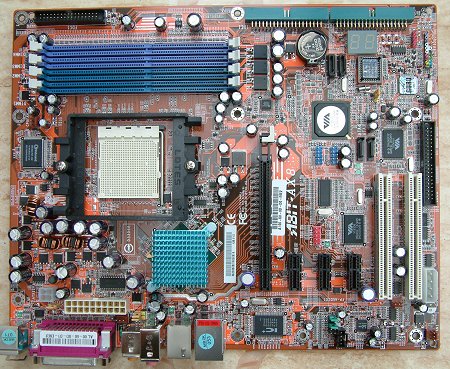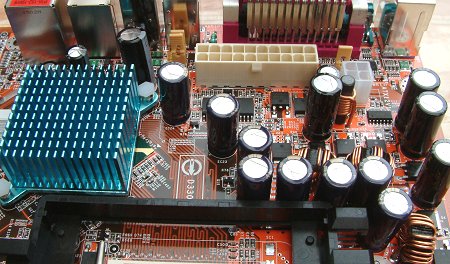Layout and features

On first glance, ABIT has done a good job in routing all the necessary features and peripherals on this standard-sized motherboard. You can immediately discern that it's a PCI-Express board by the 3 short x1 slots on the right-hand side. They help ABIT to leave the AX8 looking clutter-free. Attention on most S939 boards is usually drawn to the large retention bracket surround the ZIFF socket. AMD's cooler-mounting mechanism is, I believe, better than Intel's current LGA775 system, so even novices will have no problem during initial installation. This is helped by a generous amount of room around all but one section of the retention bracket.

A bank of high-quality capacitors surround one edge. VIA has stuck with a traditional two-bridge chipset model with the K8T890, and ABIT has done the sensible thing by passively cooling the northbridge. All too often, heatsink-mounted 40mm fans can cause annoying high-pitched noises. A lack of such a fan denotes that whilst this is still an enthusiast-based board to some extent, overclocking potential isn't a main selling point. Given its low-ish price, ABIT has got it right. The grouping of the main 20-pin and 4-pin power connectors is thoughtful, as is the use of the big-headed board jumpers that you can see immediately behind and to the left.

S939's large cooler bracket and the use of 4 DIMM slots that should be run in the preferred dual-channel form has forced ABIT into pushing both primary and secondary IDE ports to one side of the board. ABIT's rotated both ports to marginally save on PCB usage. This kind of layout actually works out pretty well; hard drives are generally located nearer the bottom of cases and IDE cables are long enough to stretch to optical drives housed in all but the largest tower cases.
ABIT's handy debug LED makes an appearance here, but it seems that some error codes aren't highlighted in the otherwise comprehensive manual. Code 10, for instance. The clear CMOS position and jumper have both been thought out. Too many times it's stuck between ASICs and not tall enough to be removed without irritation. Here it's in lots of space, and it's of the usual ABIT big-headed variety. Enthusiasts will appreciate this little attention to detail every time the board needs resetting after an overclock has gone too far. You can just about see both sets of SATA ports, emanating from the VT8237 southbridge and VT6421 controller, respectively. ABIT's µGuru monitoring chip and colour-coded motherboard-to-case pins also sit alongside.
Adding to the features fun is VIA's VT6421L SATA RAID controller that also adds in a third IDE port (non-RAIDable, sadly). Onboard sound is driven by the southbridge's basic AC'97 allied to the always-dependable Realtek ALC658 CODEC. The bemusing aspect is to why ABIT has gone with an 8-channel CODEC when a 6-channel would have sufficed. There's no extra fly panel to make use of the two extra channels, either.

At least ABIT has salvaged some of the CODEC's attributes by adding optical input and outputs on the back panel. The rest is usual fare, with the RJ45 socket playing host to Gigabit LAN. ABIT's implemented the features-set well on the AX8. The board was a cinch to set-up in a regular ATX case.









